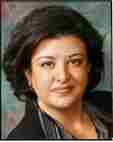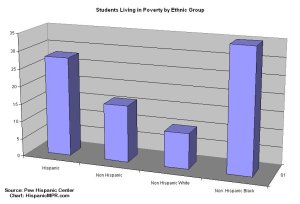Hispanic students show significant growth in public school population
Posted by Elena del Valle on September 30, 2008
Click on image to enlarge
Between 1990 and 2006 the Hispanic student population in the public school system nationwide nearly doubled. Hispanic students represent 60 percent of the overall growth in public school enrollments for that time period. About 20 percent of all public school students today are Latino; that’s 10 million Hispanic students attending public schools.
In addition, Hispanics are already the largest minority group in the public schools in 22 states. The growth is particularly evident in states which have traditionally had large Latino populations. For example, while in 1990 Latinos represented 36 percent of the public school population in California, by 2006 50 percent of all students in that state were Latino.
In 2006, in Arizona, Mexico and Texas more than 40 percent of enrollments were of Latino students. That same year, in Nevada, Colorado, Illinois, Florida and New York between 20 percent and 40 percent of students were Hispanic.
According to newly released U.S. Census Bureau demographic estimates, Hispanic student enrollment is likely to continue to grow for many years. Researchers believe that by 2050 there will be more Hispanic children than non Hispanic white children.
Find out what multicultural kids across America think
Listen to Michele Valdovinos, SVP, Phoenix Multicultural in
“Marketing to Multicultural Kids” audio recording

Michele Valdovinos gives a presentation and participates in an extended Q&A discussion about multicultural children based on a Phoenix Multicultural and Nickelodeon study of 1,300 multicultural children in 16 United States markets.
Find out about
• The Phoenix Multicultural Kids Study
• Relationship between children and their context
• Issues relating to family, technology and media, diversity, buying power, relationships in household, self perception, values, acculturation, cultural heritage, frequency of media activity, income and spending, brand preferences, the American Dream
• How many billions of dollars buying power multicultural kids children have
• Children’s spending attitudes, habits by ethnicity
• How much money a year Hispanic kids have available to spend
• Types of products Hispanic kids buy
Click here for information on “Marketing to Multicultural Kids” audio recording
A recent Pew Hispanic Center report indicate most (84 percent) Latino public school system students are United States born; seventy percent of Latino students speak a foreign language at home; 18 percent of Latino students have poor English language skills; and only slightly more than half (57 percent) of Latino children live in a household with both parents compared with 69 percent of non Hispanic white students and 30 percent of black students.
Also, 71 percent of United States born students of immigrant parents live with both of their parents compared with 58 percent of foreign born students and 48 percent of students born in the United States of native parents.
Twenty-eight percent of Latino students are poor compared with 16 percent of non Hispanic students, 35 percent of non Hispanic black students and 10 percent of non Hispanic white students. At the same time, foreign born Hispanic children are more likely to live in poverty than United States born Latinos, 35 percent and 27 percent respectively.
The Pew Hispanic Center, an initiative of the Pew Research Center, is a non-partisan, non-advocacy research organization based in Washington, D.C. The Pew Hispanic Center is funded by The Pew Charitable Trusts.
Target Latinos effectively by anticipating changes in the market with
“Hispanic Projections with 2007-08 update” audio recording

Presenter Roger Selbert, Ph.D.
Find out
- About Latino buying power growth in the future
- How Latino market growth compares with other markets in the U.S.
- What drives the rise of Latino economic clout
- Who should target the Latino market
- What is the size of the Hispanic affluent market
- If the luxury Latino market is growing
Stay ahead of your competition with “Hispanic Projections”











